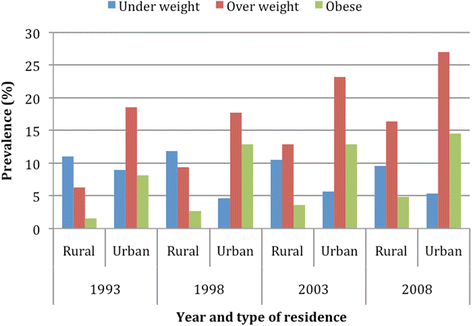Double burden of malnutrition: increasing overweight and obesity and stall underweight trends among Ghanaian women
- PMID: 26178521
- PMCID: PMC4502461
- DOI: 10.1186/s12889-015-2033-6
Double burden of malnutrition: increasing overweight and obesity and stall underweight trends among Ghanaian women
Abstract
Background: Overweight and obesity are among the leading causes of mortality globally, and although previously they were mostly prevalent in developed countries, recent scanty evidence suggests that overweight and obesity in developing countries have reached high levels. Trends in overweight/obesity (BMI ≥ 25 kg/m(2)) and underweight (BMI < 18 kg/m(2)) from 1993 to 2008 and associated factors were explored among 15 to 49 years old women in Ghana.
Methods: Nationally representative data were used from four Demographic and Health Surveys conducted in Ghana in 1993 (n = 4562), 1998 (n = 4843), 2003 (n = 5691) and 2008 (n = 4916). The data were analysed using logistic regression.
Results: Over all, underweight increased by 28.57% (from 10.5%, 95% confidence interval (CI) = 9.61-11.39 in 1993 to 7.5%, 95% CI = 6.76-8.24 in 2008) and 134.85% increase in overweight and obesity (from 13.2%, 95% CI = 12.22-14.18 in 1993 to 31 %, 95% CI = 29.71-32.29 in 2008) over the fifteen year period were found. Overweight was much more common in urban women (36.8%, 95% CI = 35.78-37.82) compared to rural women (15.6%, 95% CI = 14.93-16.27). Women of urban residents were more likely of being overweight (OR = 1.43, 95% CI = 1.25-1.63) but less likely to be underweight (odds ratio (OR) = 0.33, 95% CI = 0.30-0.36) compared to those of rural residents. Furthermore, older age, higher education, multi-parity and being rich were associated with overweight/obesity among Ghanaian women.
Conclusion: Overweight and obesity are becoming a common phenomenon among Ghanaian women while underweight still remains a problem. Our study demonstrates an emerging double burden of malnutrition among Ghanaian women. Promotion of physical activity and encouraging healthy dietary habits are urgently needed to curtail obesity and overweight trends while underweight among rural women, those without higher education and those with lower wealth index can be improved through poverty reduction measures.
Figures
References
-
- WHO . Global Health Risks. Geneva: World Health Organization; 2009.
-
- Finucane MM, Stevens GA, Cowan MJ, Danaei G, Lin JK, Paciorek CJ, et al. National, regional, and global trends in body-mass index since 1980: systematic analysis of health examination surveys and epidemiological studies with 960 country-years and 9? 1 million participants. Lancet. 2011;377:557–567. doi: 10.1016/S0140-6736(10)62037-5. - DOI - PMC - PubMed
-
- Jones-Smith JC, Gordon-Larsen P, Siddiqi A, Popkin BM. Cross-national comparisons of time trends in overweight inequality by socioeconomic status among women using repeated cross-sectional surveys from 37 developing countries, 1989–2007. Am J Epidemiol. 2011;173:667–675. doi: 10.1093/aje/kwq428. - DOI - PMC - PubMed
Publication types
MeSH terms
LinkOut - more resources
Full Text Sources
Other Literature Sources
Medical



